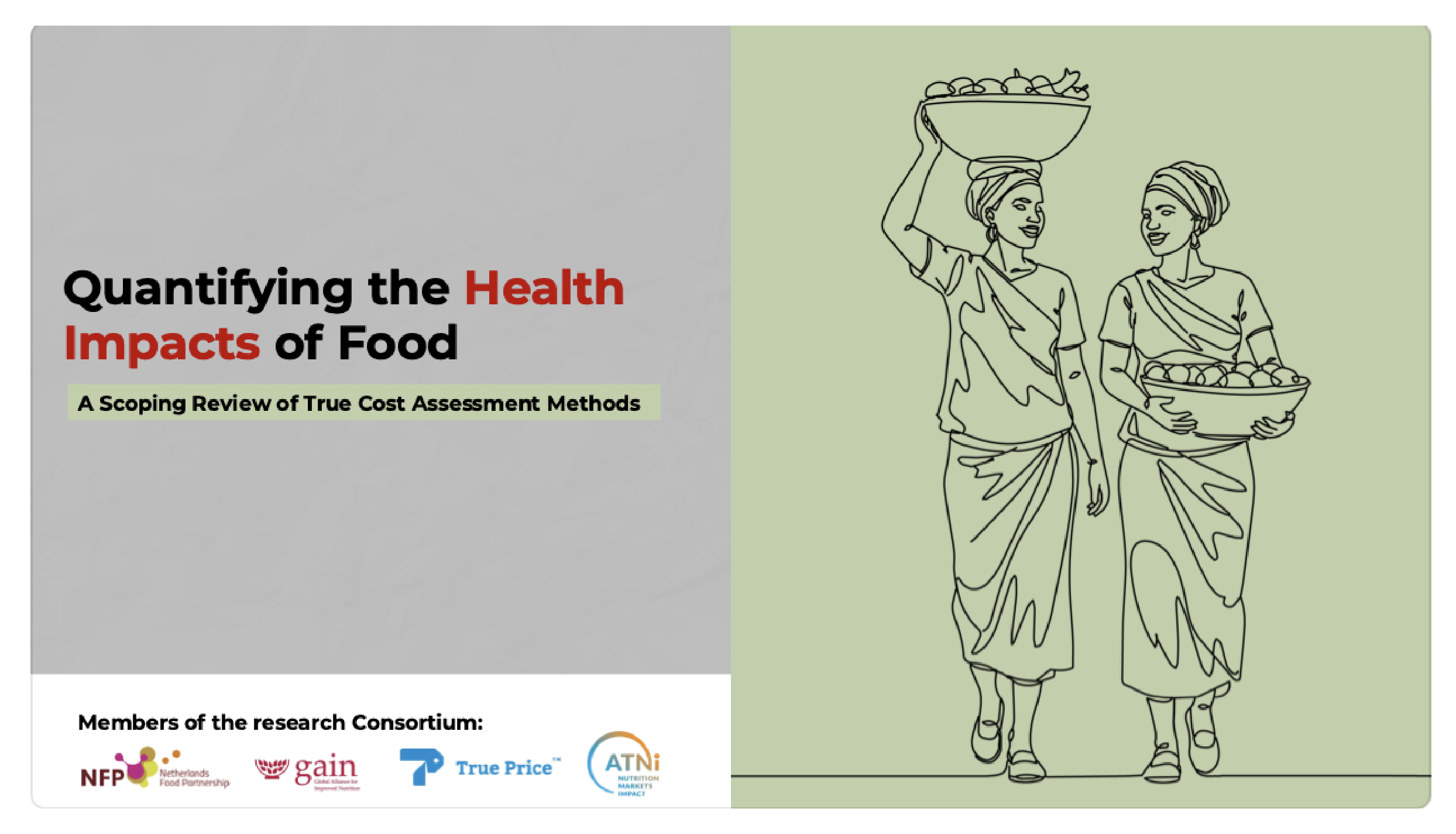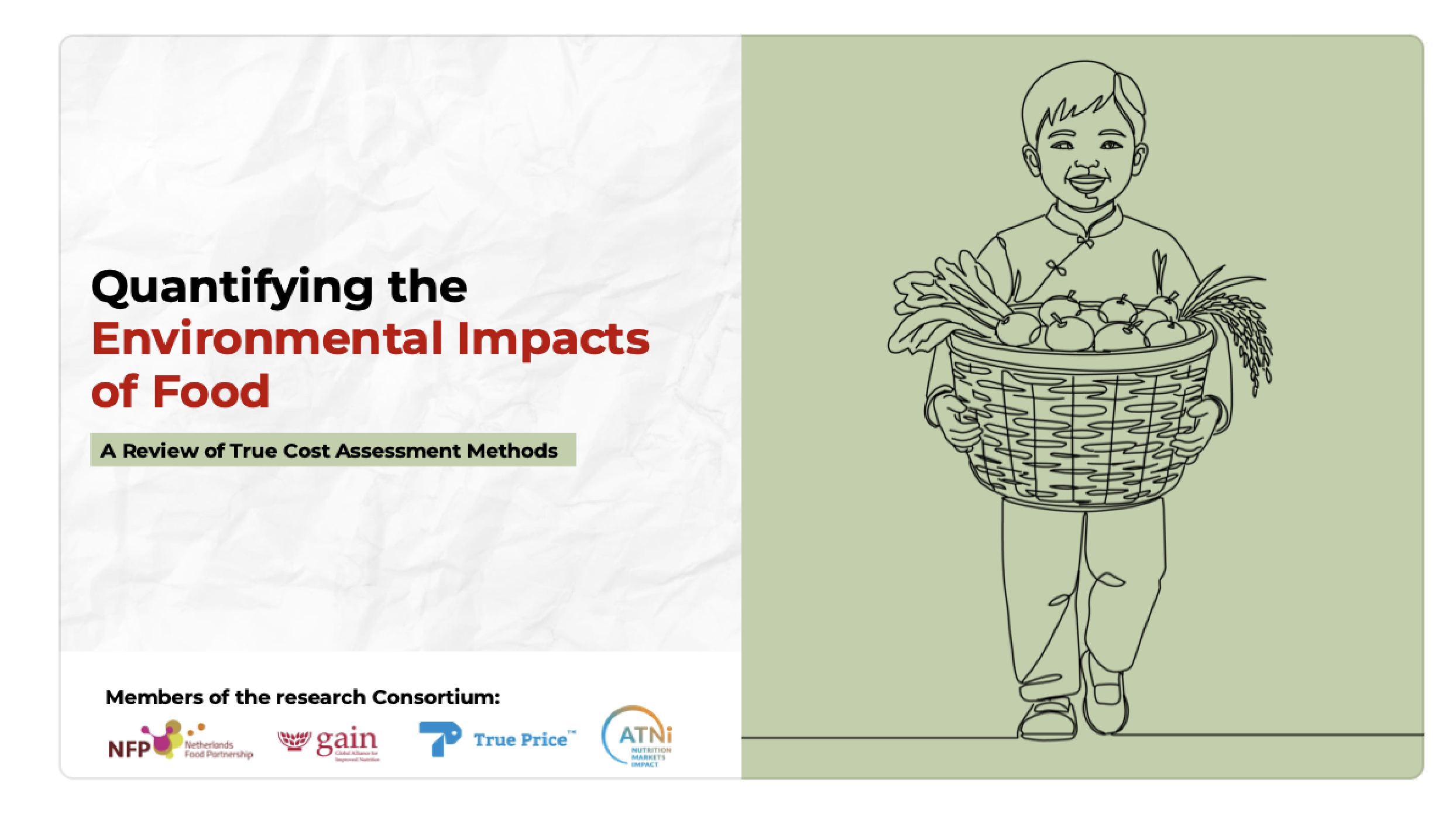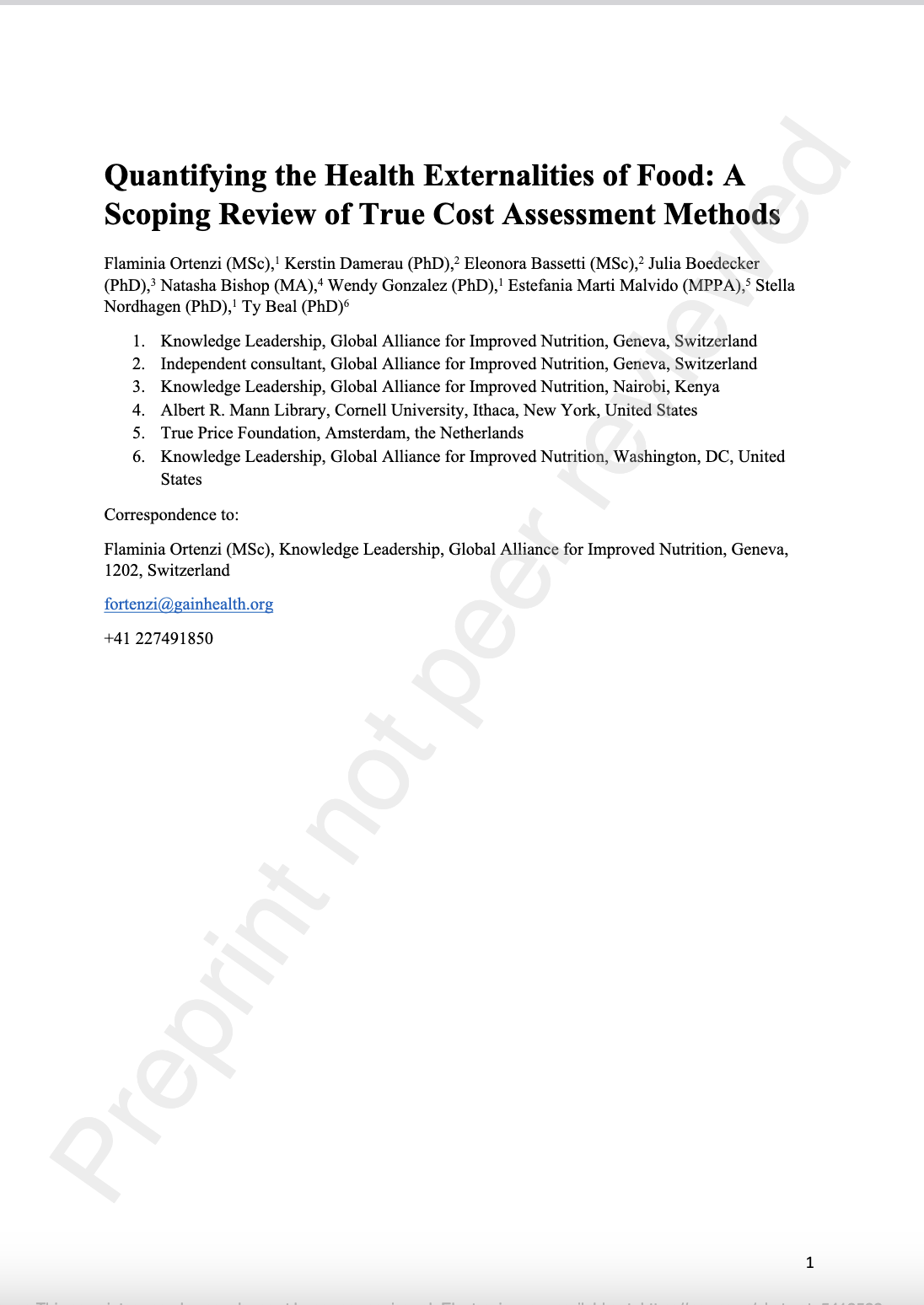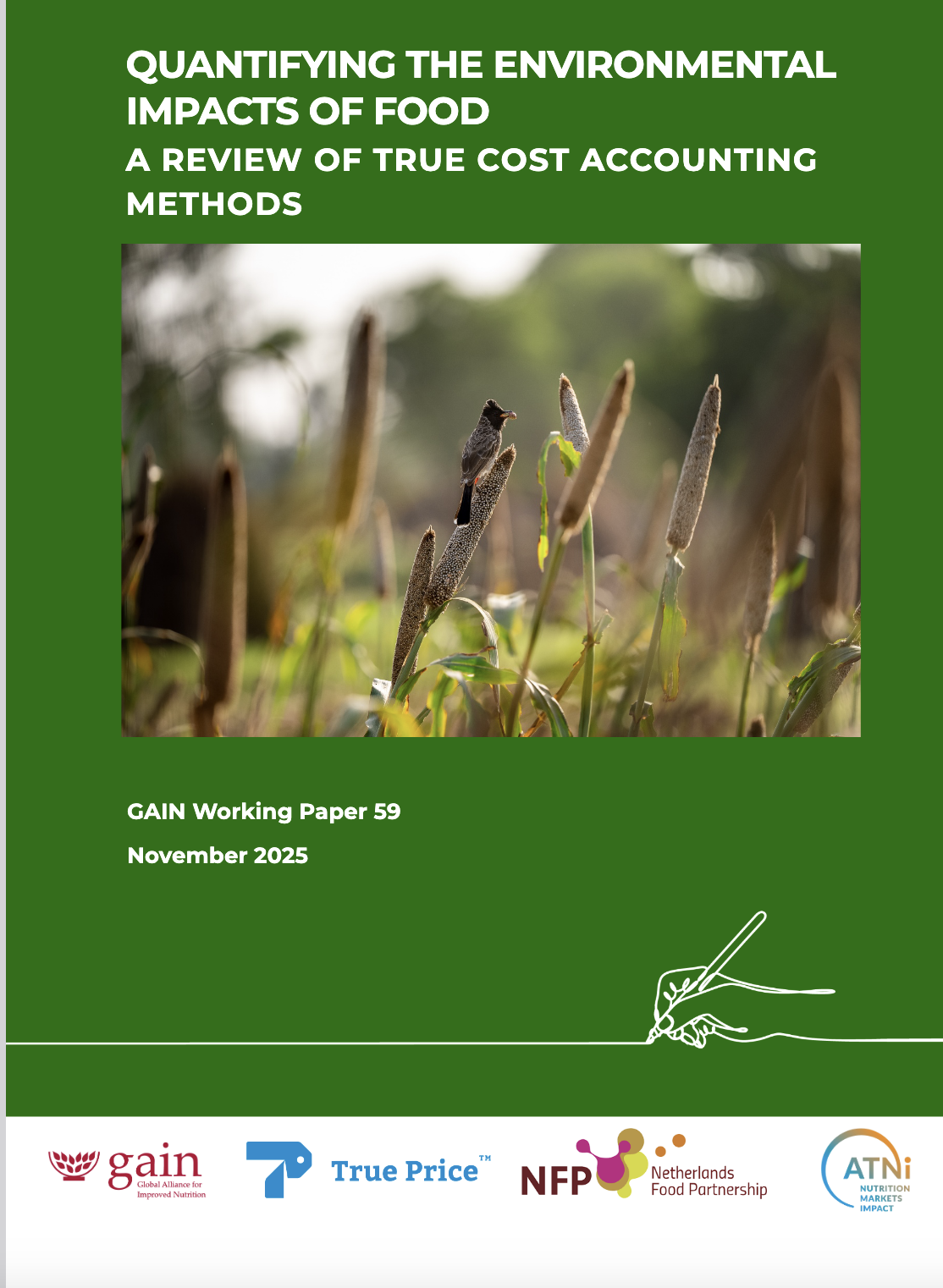Global food systems generate a wide range of health, environmental, and socio-economic externalities that vary across regions, demographic groups, value chains, and production contexts. These include positive effects such as improved food and nutrition security, better air and water quality, job creation and community development, but also negative outcomes such as malnutrition and diet-related diseases, climate change and land degradation, unfair labour practices and rights violations. Yet, these costs and benefits are rarely reflected in the market price of food. To design future food systems that promote health, environmental sustainability, social equity/justice, and resilience, we must make these hidden impacts visible and act upon them.
The Global Alliance for Improved Nutrition (GAIN), Netherlands Food Partnership (NFP), True Price Foundation (TPF), and Access to Nutrition Initiative (ATNI) (hereafter referred to as ‘the Consortium’), have undertaken a landmark three-part review series on True Cost Accounting approaches for food system applications. Their work synthesises and critically analyses existing methods for measuring and monetising the impacts of foods and diets across health, environmental, and socio-economic dimensions. The review series represents the first step within a broader initiative by the Consortium aimed at determining the True Cost and True Price of observed (currently consumed) and recommended (based on national dietary guidelines) food baskets in both high- and low- and middle-income countries. Building on the True Price Assessment Method for Agri-Food Products, the partners seek to further develop and implement available frameworks, approaches, methods, and tools to comprehensively assess health, environmental, and socio-economic externalities, while also considering nutritional value and affordability of food basket options.
So what Is True Cost Accounting?
True Cost Accounting (TCA) is a systems approach that allows measuring and economically valuing a wide range of positive and negative impacts of products, services, or entire sectors (including agri-food systems), encompassing environmental, health, and socio-economic dimensions. Unlike traditional financial accounting which overlooks hidden externalities, TCA provides a holistic view of the true costs and benefits of foods and diets on individuals, the planet, and society at large. Building on the concept of TCA, True Pricing relates the quantified externalities to product prices, enabling direct comparison or potential incorporation of external costs into market/procurement prices. The resulting “true prices” reflect the full value of foods, which includes internal (e.g., agricultural inputs, energy, labour) and external costs (e.g., environmental degradation, labour exploitation, and health burdens).
Key findings from the Review Series
This comprehensive three-part review series, analysing over 200 TCA studies across Health, Environment, and Socio-Economic domains, has revealed clear, cross-cutting patterns and critical evidence gaps in the rapidly growing field of food system valuation.
The massive and systemic scale of hidden costs
The most striking finding is the massive, hidden scale of food system impacts that are systemically overlooked. Global food system externalities are estimated at over USD 11 trillion annually, a figure surpassing the GDP of many major economies. Health costs are the largest contributor to this burden, with diet-related diseases and conditions alone accounting for an estimated USD 8.1–9.8 trillion annually in some large-scale assessments. Notably, in both the Health and Socio-economic domains, current estimates show that indirect costs – such as productivity losses from illness, exploitative labour practices, and premature death – consistently outweigh direct expenditures (like medical bills or fine payments for violations). Furthermore, the pervasive exclusion of intangible costs (such as pain and suffering) and the often-ignored positive externalities mean that existing analyses/models are likely underestimating the true societal cost and value of food systems.
Technical and data challenges in current methodologies
The fragmented nature of the available TCA literature hinders its usefulness for policy influencing and scenario comparisons. Existing approaches often create trade-offs for researchers, who must choose between achieving a broad, macro-level scope (relying on top-down, model-driven data) and providing local, context-specific results (using granular, bottom-up data). This fragmentation is compounded by a focus on isolated value chain stages (e.g., only 10% of environmental studies cover foods’ entire lifecycle) and single foods / food groups (e.g., 71% of socioeconomic publications), failing to capture the dynamic, interconnected nature of food systems and the complexity of whole diets. Additionally, most methods are ‘reactive’, focusing on documenting costs after harm has occurred (e.g., social / damage cost), rather than assessing ‘proactive’ measures related to prevention. Finally, research suffers from high methodological heterogeneity, cross-study inconsistencies, and over-reliance on proxy or global average data, which does not capture specific local conditions.
The imperative for equity and inclusion
The evidence reveals a stark geographical and analytical imbalance. Research is heavily concentrated in high-income countries (HICs), severely limiting the applicability and relevance of results for low- and middle-income countries (LMICs), where the actual costs of poor health, poor livelihoods, and environmental degradation are disproportionately borne. A critical identified gap is the absence of studies monetising malnutrition from micronutrient deficiencies while directly linking it to dietary patterns. Moving forward, the TCA field must address the ethical dilemma of internalising external costs into products’ market prices, which risks commodifying non-negotiable, non-substitutable values like human rights and dignity. To truly transform food systems, future efforts must prioritise equity by investing in inclusive TCA methods that capture the disproportionate burden carried by vulnerable populations and ensure reliable, disaggregated data systems are established in LMICs.
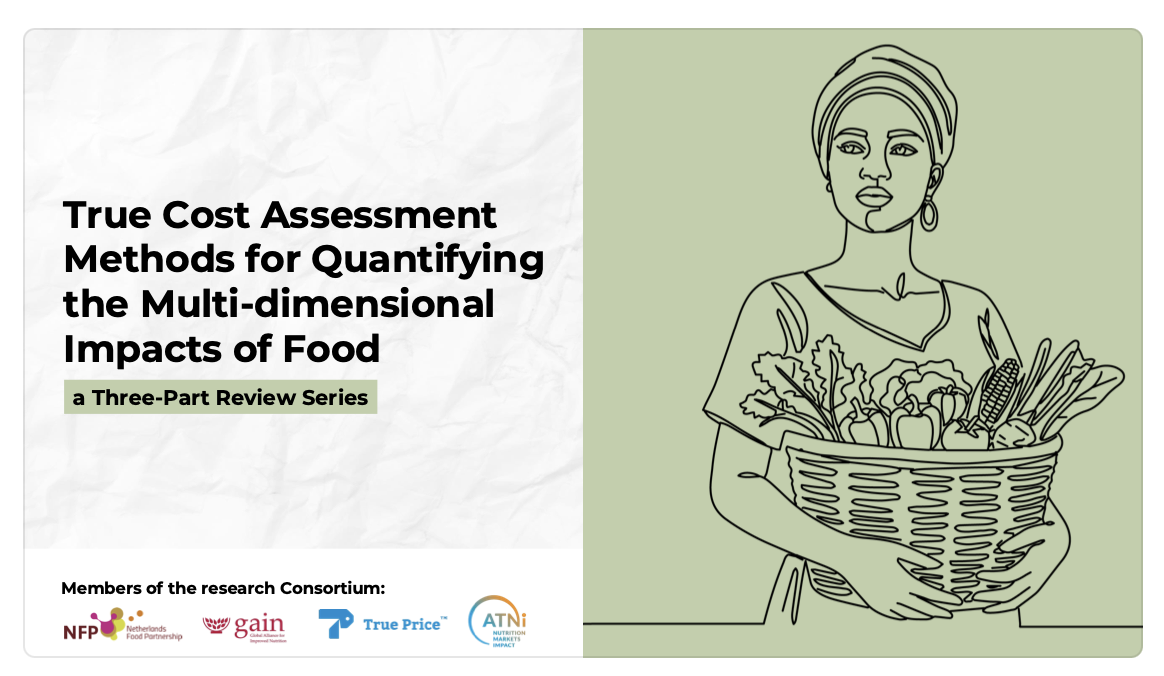
High-level Insights Across Three Domains
1. Health Impacts : Diet-related diseases (e.g., cardiovascular disease, diabetes) account for the largest share of food system externalities, costing trillions annually in lost productivity and premature deaths.
The Health review maps methods for assessing how food production and consumption contribute to malnutrition and diet-related diseases, food- and waterborne illnesses, health harms from environmental contamination / pollution, and occupational health risks. It also illustrates how these burdens can be expressed in economic terms.
2. Environmental Impacts : Global food systems are responsible for 30% of anthropogenic greenhouse gas emissions and 70% of freshwater withdrawals, and are the leading cause of deforestation and biodiversity loss. The Environmental review identifies and categorises theoretical frameworks, approaches, and analytical techniques for monetising these externalities, converting impacts such as climate change, water scarcity, and land degradation into monetary values.
3. Socio-Economic Impacts : More than 1 billion people globally depend on food systems for their livelihoods, yet many face unfair wages, unsafe working conditions, and various forms of discrimination. The Socio-economic review highlights how frameworks, approaches, and methods to quantify and economically value these impacts can inform more just, inclusive, and resilient food systems.

Why It Matters
This review series reveals that while TCA and True Pricing of food system externalities are rapidly gaining traction, current methods remain fragmented, lack transparency, and are heavily skewed toward high-income countries.
The stakes are enormous: without enhanced, standardised tools and geographically representative data, decision-makers risk systematically underestimating the full scale of food-related impacts, which are already valued at over USD 11 trillion annually. This figure underscores that food systems’ pervasive health, environmental, and socio-economic externalities impose a massive, unpriced burden on people and the planet.
This landmark work clearly identifies where evidence is strongest (e.g., health costs of alcohol and sugar-sweetened beverage consumption), where gaps persist (e.g., monetisation of micronutrient deficiencies, valuation of environmental impacts other than GHG emissions), and what future research must address to make TCA a reliable, actionable, and equitable tool for system transformation. By making these hidden impacts visible, we can ensure that the true value of food drives informed decisions by all food system actors.
Key Takeaways
• Global food system externalities exceed USD 11 trillion per year.
• Health costs are the largest share, but environmental and socioeconomic costs are also significant.
• TCA methods have rarely been applied in low- and middle-income countries.
• Fragmented and highly heterogenous methodologies limit comparability of cost estimates across studies.
• Stronger data systems, interdisciplinary research, and participatory approaches are essential to scale up TCA as a practical, evidence-based tool for decision-making.
A Call to Action
Revealing the true cost of foods and diets can enable researchers, policymakers, businesses, and civil society to work collaboratively towards food systems that are healthier, fairer, and more sustainable. Investing in improved methodologies and data infrastructure will help ensure that the multi-dimensional impacts of our food production and consumption choices are widely recognised, driving transformative change for people, planet, and prosperity.
